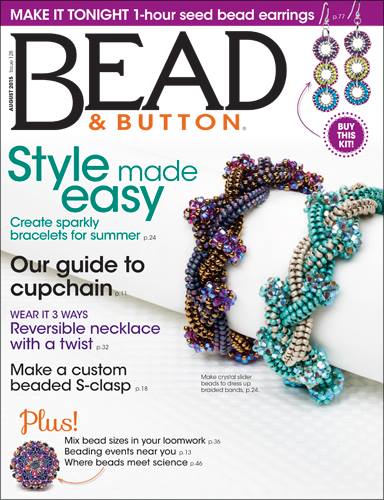My third Designer of the Year project for Beadwork Magazine is now available in the June/July 2015 issue.
The Garden Jewel Necklace features a great big Swarovski crystal bezeled with a collection of Miyuki Tila beads, drop beads, and round Japanese seed beads. A beaded spiral rope matches the focal pendant, and several beaded beads reminiscent of the Dewdrop beaded bead design string onto the rope for added texture.
The beaded beads will just fit over the spiral rope, yet they will stay in place once strung, so they can be positioned at different points on the rope for several different looks. In this purple and green version they sit close to the pendant:
And in this silvery purple version they are distributed more evenly throughout the rope:
A limited number of kits for this project are available on my website at beadorigami.com. The pattern for this design is available in the June/July 2015 issue of Beadwork Magazine. Please note that I'll soon be traveling to the 2015 Bead & Button Show, and the last day to order kits for shipment before the show is June 1. Any kits ordered after June 1 will ship on June 9.
Thanks for looking!
The Garden Jewel Necklace features a great big Swarovski crystal bezeled with a collection of Miyuki Tila beads, drop beads, and round Japanese seed beads. A beaded spiral rope matches the focal pendant, and several beaded beads reminiscent of the Dewdrop beaded bead design string onto the rope for added texture.
The beaded beads will just fit over the spiral rope, yet they will stay in place once strung, so they can be positioned at different points on the rope for several different looks. In this purple and green version they sit close to the pendant:
And in this silvery purple version they are distributed more evenly throughout the rope:
A limited number of kits for this project are available on my website at beadorigami.com. The pattern for this design is available in the June/July 2015 issue of Beadwork Magazine. Please note that I'll soon be traveling to the 2015 Bead & Button Show, and the last day to order kits for shipment before the show is June 1. Any kits ordered after June 1 will ship on June 9.
Thanks for looking!






































